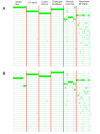Large scale clustering of protein sequences with FORCE -A layout based heuristic for weighted cluster editing
- PMID: 17941985
- PMCID: PMC2147039
- DOI: 10.1186/1471-2105-8-396
Large scale clustering of protein sequences with FORCE -A layout based heuristic for weighted cluster editing
Abstract
Background: Detecting groups of functionally related proteins from their amino acid sequence alone has been a long-standing challenge in computational genome research. Several clustering approaches, following different strategies, have been published to attack this problem. Today, new sequencing technologies provide huge amounts of sequence data that has to be efficiently clustered with constant or increased accuracy, at increased speed.
Results: We advocate that the model of weighted cluster editing, also known as transitive graph projection is well-suited to protein clustering. We present the FORCE heuristic that is based on transitive graph projection and clusters arbitrary sets of objects, given pairwise similarity measures. In particular, we apply FORCE to the problem of protein clustering and show that it outperforms the most popular existing clustering tools (Spectral clustering, TribeMCL, GeneRAGE, Hierarchical clustering, and Affinity Propagation). Furthermore, we show that FORCE is able to handle huge datasets by calculating clusters for all 192 187 prokaryotic protein sequences (66 organisms) obtained from the COG database. Finally, FORCE is integrated into the corynebacterial reference database CoryneRegNet.
Conclusion: FORCE is an applicable alternative to existing clustering algorithms. Its theoretical foundation, weighted cluster editing, can outperform other clustering paradigms on protein homology clustering. FORCE is open source and implemented in Java. The software, including the source code, the clustering results for COG and CoryneRegNet, and all evaluation datasets are available at http://gi.cebitec.uni-bielefeld.de/comet/force/.
Figures



References
-
- Rahmann S, Wittkop T, Baumbach J, Martin M, Truß A, Böcker S. Exact and Heuristic Algorithms for Weighted Cluster Editing. Comput Syst Bioinformatics Conf. 2007;6:391–401. - PubMed
-
- Delvaux S, Horsten L. On best transitive approximations of simple graphs. Acta informatica. 2004;40:637–655.
-
- Shamir R, Sharan R, Tsur D. Cluster graph modification problems. Discrete Applied Mathematics. 2004;144:173–182.
-
- Pipenbacher P, Schliep A, Schneckener S, Schoenhuth A, Schomburg D, Schrader R. ProClust: improved clustering of protein sequences with an extended graph-based approach. Bioinformatics. 2002;18:S182–S191. - PubMed
MeSH terms
Substances
LinkOut - more resources
Full Text Sources

